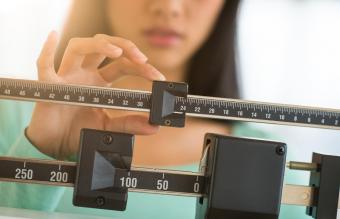
Menstrual cramps, also known as dysmenorrhea, are a monthly nightmare for many women. Ranging from being a nuisance to debilitating, some women turn to over-the-counter or prescription painkillers to ease discomfort. Medication isn't the only remedy; specific foods may also help.
Relieve Menstrual Cramps With Food
Most women tend to eat more during their periods, thanks to hormone fluctuations. Unfortunately, many tend to eat unhealthy "comfort" foods that are high in sugar and fat. These foods may worsen menstrual symptoms such as bloating, mood swings and pain.
According to Tori Hudson's Women's Encyclopedia of Natural Medicine, the most important foods to avoid during menstruation are those that contain high levels of arachidonic acid. Arachidonic acid is used by the body to produce series-2 prostaglandins (PgE2) which cause muscle and uterine contractions. The book states that red meat, egg yolks and poultry are main sources of arachidonic acid. She suggests avoiding these foods during menstruation and also avoiding salt and saturated fats.
To help relieve your pain and other symptoms, Hudson advocates eating foods that increase antispasmodic prostaglandins. These include the following:
Calcium Rich Foods
It's unclear how calcium helps relieve menstrual pain but according to the University of Maryland Medical Center (UMM), it may help maintain muscle tone. Foods rich in calcium include beans, dark leafy greens and almonds. The daily recommended allowance of calcium per day is 1,000 mg. If you cannot obtain this through your diet, talk to your doctor about taking calcium supplements.
Hudson cautions that since many people are allergic or sensitive to dairy, dairy sources of calcium may worsen discomfort. As a result, she recommends obtaining calcium through non-dairy sources.
Omega-3 Foods
According to Natural Health's 1001 Natural Remedies, omega-3 fatty acids support the production of pain-relieving chemicals. Foods high in omega-3s include cold water fish such as salmon, cod, sardines and halibut; walnuts and flaxseeds, hemp seeds and pumpkin seeds. You can easily toss a handful of seeds into a smoothie or over a salad. UMM recommends eating 6 grams of omega-3s each day to help relieve cramps.
Whole Grains and Fiber
According to a PubMed abstract, a study showed that dietary fiber is "inversely proportional to menstrual pain." Fiber also helps regulate the bowel. Good sources of whole grains and fiber include beans, brown rice, oats, rye, barley, popcorn and whole wheat.
Fruits
Hudson writes that "fruits are an excellent form of natural anti-inflammatory substances like bio-flavonoids and vitamin C." She indicates that these nutrients not only help strengthen the blood vessels but also reduce menstrual cramps thanks to their anti-inflammatory effects. Some great options are blueberries, cherries, citrus fruits and tomatoes. During your menstrual cycle, try to eat fruit with every meal or, better yet, regularly incorporate fruit in your diet on a daily basis.
Foods Containing Magnesium
UMM recommends getting 360 mg of magnesium for 3 days before your period starts to help relieve cramps. Although this can be done through supplementation, you can also obtain this amount through the foods you eat. Try these great magnesium sources:
- Almonds
- Oatmeal
- Avocado
- Bananas
- Spinach
- Kale
- Peanuts
- Peanut butter
- Salmon
- Black beans
When you plan your meals around these foods, you can easily hit the recommended amount. You can also combine magnesium foods. For example, slice a banana into your morning oatmeal or toss a handful of almonds and some diced avocado into a fruit smoothie.
Herbal Teas
Herbal teas were used to relieve painful periods long before NSAIDS or acetaminophen existed. Although most evidence supporting their use for cramps is anecdotal, women often experience significant relief.
Many herbal teas are believed to have natural antispasmodic effects on the uterus and also help relax nerves. Following are some teas commonly used to relieve menstrual pain. Try replacing your morning mug of coffee with one or sip a cup before bedtime.
- Ginger
- Cramp Bark
- Chamomile
- Peppermint
- Raspberry Leaf
To avoid potential side effects or drug interactions, do not use an herbal remedy without consulting your doctor or natural health practitioner, especially if you are pregnant or breast feeding.
A Healthy Diet Helps Relieve Cramps
When considering foods to eat to help with menstrual cramps, keep in mind that it can take weeks or months to see the full benefit. If the dietary changes approved by your physician don't help ease your pain, follow up with your health care provider.
Recommended foods for cramp relief are healthy overall and can easily be incorporated into a healthy diet. Eating these foods over the long term may not only relieve your pain but increase overall health.







